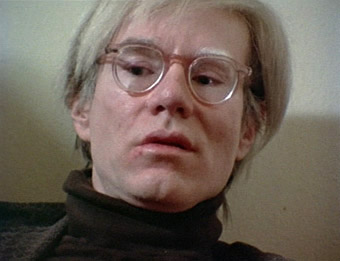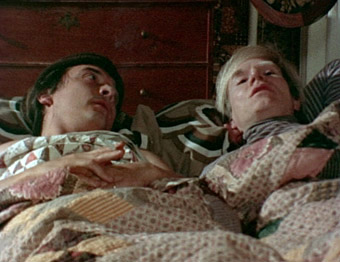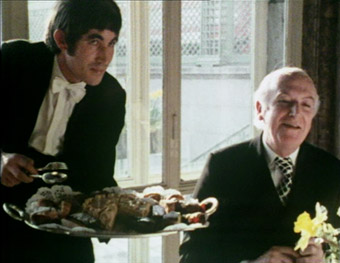Andy said a lot of things
I stored them all away in my head
Sometimes when I can't decide what I should do
I think what would Andy have said
He'd probably say you think too much
That's 'cause there's work that
you don't want to do
It's work, the most important thing is work |
Work, from the album
Songs for Drella – Lou Reed |
Andy Warhol, or Andrew Warhola as he was born, was an artist with no real equivalent in the art scene of today, one whose name is known even by those who profess no interest in his work and who became an iconic beacon for like-minded souls. His face is instantly recognisable (only David Hockney can give him a run for money on this score) and he's still credited as the father of Pop Art, one of the few art movements that isn't an 'ism' and one that can still prompt traditionalists to dismissively shake their heads. His work continues to sell for ludicrous sums – in 2007 his 1963 Green Car Crash fetched a whopping $71.7 million, from an opening bid of $17 million.
He also created The Factory, a Manhattan studio that became a magnet for friends, aspiring artists, recreational drug users and image conscious hangers-on. It's a community that produced some important and exciting work in a variety of media – The Velvet Underground were a pet project of Warhol's – but on 3rd June 1968 this experiment took a dark turn when radical feminist Valerie Solanas, author of a manifesto for S.C.U.M. (Society for Cutting Up Men), walked into the studio and emptied a gun into Warhol and curator Mario Amaya. Amaya escaped with minor injuries, but Warhol's wounds were nearly fatal – surgeons had to open his chest and manually massage his heart to revive him. Understandably, perhaps, he and his work were never quite the same again.

Five years later celebrated British photographer David Bailey flew to New York with a TV film crew looking to paint a cinematic portrait of Warhol by interviewing him and his fellow Factory artists. No-one here is identified by name and the passing of time will probably have rendered most of them anonymous to those not seriously clued up on the early 70s Factory scene. Warhol himself initially plays to the commonly held image of him, quietly and motionlessly observing as others buzz around him like party flies, his most common verbal response (if an early brief montage is to be believed) being a semi-surprised "Oh really?" Early attempts to interview him are amusingly deflected, as he mimes to pre-prepared responses delivered by an off-screen associate.
But slowly the barriers begin to fall. A discussion about Warhol's famous screen prints may not get Bailey the answers he's looking for, but it does at least feel as if the two are starting to connect, a bond that has clearly grown by the film's most surprising sequence, when Bailey and Warhol drive out to the country and the artist's self-created public image is temporarily stripped away, revealing a man still recovering from his injuries who enjoys horse riding and walking on the beach with his dog. It's following this that Bailey gets his best interview material, from a conversation conducted in bed in which Warhol talks openly about the shooting and its resulting scars, to Fred Hughes' hair-raising recollection of the incident and how close he came to being killed.
On the way we're treated to a number of asides that many will see as typical of the Factory and its inhabitants. One girl strips to her waist and makes ink prints of her breasts while asking Warhol to define Pop Art by phone, another loudly sings "I'm just wild about Andy" and pulls Bailey from behind the camera to dance, and a resident filmmaker tells us that "Everybody tries to make films very well nowadays so we go in the opposite direction, we try to make them as badly as possible." It's actually hard to know whether Warhol is serious when he replies to Bailey's enquiry about why he no longer likes paintings by telling him: "I never did – I just like painted walls," a seemingly flip answer that his subsequent explanation renders more credible.
It may meander a little in places and it's not as structurally adventurous as you might expect for a film designed to "capture the spirit of Warhol using some of the techniques which he has pioneered." But it's still a playful, engaging and occasionally revealing peek into the world of one of the key figures of twentieth century art, and its value as a historical document – of its maker as well as its subject – is considerable.
All three films on this disc (the other two are detailed below) were shot on what looks like high speed 16mm, and Warhol and Beaton by Bailey have undergone some unspecified restoration since their previous DVD release (more on this below). The resulting picture is certainly clean, but colours remain muted and the image soft, though the contrast feels about right. There's a brown-green hue to some scenes that could be a light balance issue with the original footage. Visconti has not been restored and there's thus a lot more dirt to contend with, though even here there are stable stretches and the sharpness is on a par with the others.

The Dolby 2.0 mono tracks are functional, but some background crackle and hiss are audible here and there and there's a slight treble bias on some of the dialogue. Just occasionally things dip a bit further – the sequence in which one of Warhol's superstars interviews him about his planned musical, for instance – but for the most part the soundtracks do their job and feel about right for filmed television of the period.
It's a tricky call as to whether the other films on this disc actually count as extra features or should be given equal billing. This was certainly the case on the 2006 release of this disc, which back then was titled Bailey On. Here the Warhol documentary is being showcased as the main feature, despite all three included films being from the same ATV series. That Warhol was originally banned gives it a reputation edge over the others, but I'm wondering if someone at Network simply shares my own personal preferences here, particularly in regard to..
Beaton by Bailey (52:14)
Now I'm not saying that Cecil Beaton isn't interesting in himself, as his international success and influence as a people photographer makes him ripe for a documentary portrait, but while some of The Factory members may prompt a cynical smile, I do at least connect with their artistic ambitions and fondness for experimentation. Beaton, on the other hand, moves in a world so divorced from my own that it might as well be in another solar system. Following an engaging opening in which Bailey photographs his willing subject as he walks around a sizeable English country garden, we drop in on a number of Beaton's friends and associates, many of whom are Lord or Lady something-or-other and speak with the sort of plummy accents that nowadays play almost like parody. Even the blokey Bailey appears to be putting on a bit of a voice, though this is all nicely sent up by Mick Jagger, who adopts a posh accent to relate an anecdote he then dismisses as invented, returning to his normal growl to reveal that the only thing he knows about Beaton is that "he takes good pictures."

Which brings me to my second barrier to engagement, as while I'm fascinated by much of Warhol's art and even Bailey's portraiture, Beaton's work has always left me cold. As the film progresses there's a sneaking suspicion that maybe Bailey himself is not as big a fan as he initially makes out, with two of the models interviewed expressing dissatisfaction with the results of their photo sessions and Bailey offering some polite criticism on the clutter in Beaton's early work. There's a brief moment of surrealism when Patrick Lichfield and Brian Duffy engage in conversation in an upside-down room, and late in the film there's a neat slice of caught-by-chance (and possibly unintended) social commentary when Beaton and an old friend meet in The Ritz restaurant – as a young waiter stands awkwardly bent forward in a frozen pose of servitude to his wealthy masters, the two customers burst into nostalgic song and pay the poor waiter absolutely no heed, leaving him to glance uncertainly around in a state of obvious discomfort while they indulge in their trivial pleasures. It's as sly a comment on the so-called ruling classes as I've seen all year.
Count Luchino Visconti of Modrone (27:09)
Half the length of its companions, Bailey's film portrait of Italian director Luchino Visconti is less substantial but every bit as playful as its companions, flitting between Arena-style interviews with the director, on-set footage of the shooting of Ludwig, and conversations with Visconti and actors Romy Schneider and Helmut Berger. Visconti talks about his early life and career, Schneider laughs at Bailey's interview technique and runs in the woodland with her partner, and Berger complains that he's fed up with an interview that he was clearly uninterested in doing in the first place. He does neatly cut short a peculiar early preoccupation of Bailey's regarding homosexual characters in films, however. An interesting piece, if a little content light.
The release disc apparently also includes a booklet containing transcripts of all three films, including deleted scenes, but this was not included with the review copy so cannot be commented on.
A DVD re-release that sees two of the three films cleaned up and one headlined over its companions. Given that it's the best of the three I have no problem with this, but if you already have Network's earlier Bailey On disc your decision on whether to re-purchase will be based solely on the restoration, and not having seen the original release I can't comment on the improvement this represents. As someone who regularly complains about the unavailability of much of the treasure trove of past British arts and documentary programming, I welcome any such DVD release, and a print clean-up is always welcome. It's just a shame Bailey couldn't have been persuaded to provide a commentary or three. Otherwise, nice one.
|